Foresters and loggers rely on a variety of tools and equipment to properly do the work of cutting and processing trees. Here is a brief overview of the basic types of equipment needed for optimal performance.
Delimbers
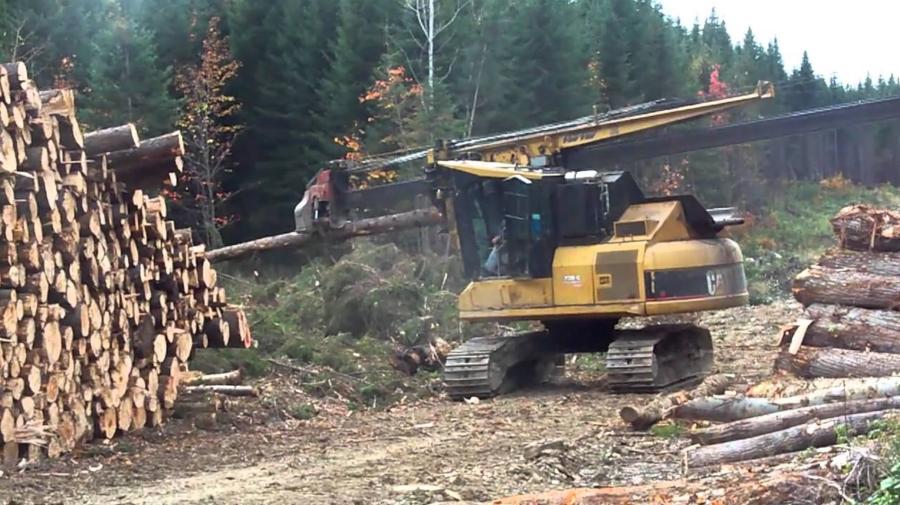 Delimbers are vital tools in forestry and logging work. There are three basic methods for delimbing a tree: gate, pull-through and flail. All three are landing-based, and relatively low-cost, and most suitable for situations where the quality of the remaining wood is not an issue.
Delimbers are vital tools in forestry and logging work. There are three basic methods for delimbing a tree: gate, pull-through and flail. All three are landing-based, and relatively low-cost, and most suitable for situations where the quality of the remaining wood is not an issue.
Gates are steel structures welded into a grid pattern. A grapple skidder moves a load of trees through the gates, thereby breaking off the limbs. Gate delimbers are used in conjunction with a chipper or as part of a system that loads the delimbed stems directly onto a truck.
Pull-through delimbers are horizontally-mounted processors, capable of being either standalone or trailer-mounted. A loader places a tree in the delimber, where a system of three or more knives grip the trunk in order to pull the tree through the processor. Many models also feature a topping saw to remove the head of the tree. Pull-through delimbers provide a cleaner stem than gate delimbing and rarely require additional processing prior to truck loading.
Flail delimbers are rotating drums with chains. The chains break off the limbs when trees are fed through the drum. Flails may be either self-feeding or loader triggered, in which case a loader or a skidder pulls the tree through. This method also removes bark, which is useful when the end goal is a very low bark content within the resulting chips, such as for pulp or paper usage.
Feller Bunchers
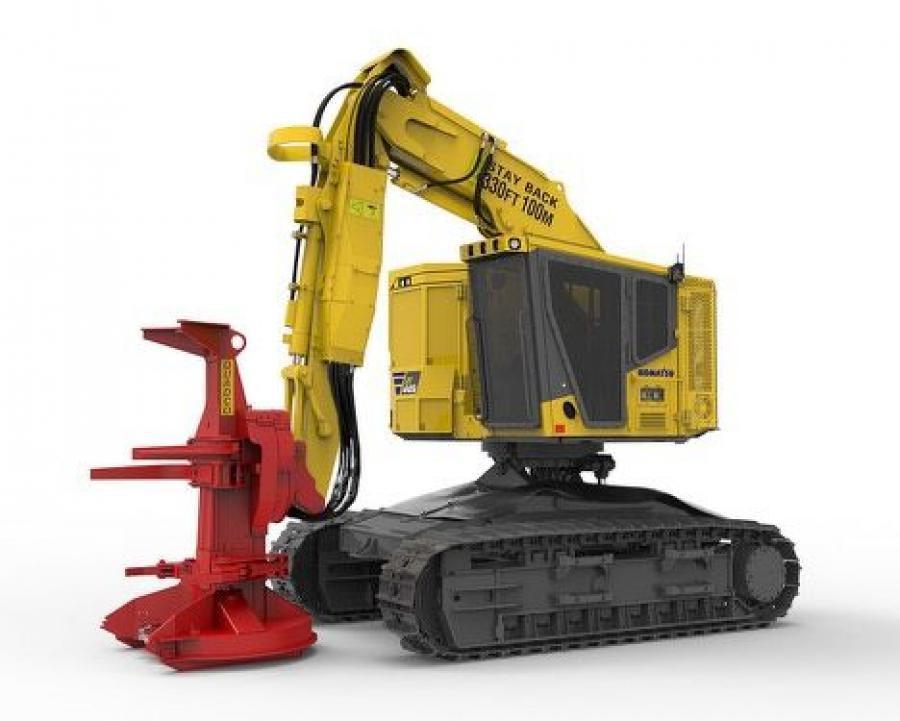 Feller bunchers are self-propelled machines with a single cutting head. Capable of gripping more than a single stem at once, the cutting heads function only as a cutting, holding and ground placement device. They do not have processing capabilities.
Feller bunchers are self-propelled machines with a single cutting head. Capable of gripping more than a single stem at once, the cutting heads function only as a cutting, holding and ground placement device. They do not have processing capabilities.
Feller bunchers are propelled by wheels or tracks. Tracked machines operate more slowly, but offer greater stability
Wheels or tracks propel feller bunchers. Tracked machines are slower than wheeled machines, but have the advantage of greater stability on steeped locations. They also can operate on wet and loose soils where rubber-tired machines cannot. Further, feller bunchers sometimes have self-leveling cabs that extend the slope on which they operate.
There are two other major differences between feller bunchers. A drive-to-tree feller buncher has rubber tires that allow it to drive up to trees to cut with its carrier-mounted cutting head. A swing boom feller buncher has tracks only, while the cutting head is mounted to a boom. This model style need not be driven to trees before cutting.
Feller bunchers have head attachments built for mounting either to a boom or the chassis of a base carrier. There are three categories of felling heads: bunching heads, processing heads and straight felling heads. Bunching heads handle multiple stems and cannot process trunks. Processing heads can both fell and process trees. Felling heads cut and fell single stems, yet have no processing capabilities.
Feller bunchers are applicable in both thinning and clear cutting situations. Their ability to control the felling process reduces stand damage when compared with manual felling styles. Because they do not have processing capabilities, the entire tree is routinely extracted to the landing. When felled trees are left in the woods, separate limbing and/or topping procedures must occur prior to extraction. Feller bunchers are ideal when stems fall within the range of bunching head capabilities.
Finally, feller bunchers are built with Rollover Protective Structures (ROPS) and Falling Object Protective Structures (FOPS) to protect operators. Whether on flat ground or steep slopes, large trees are extremely heavy and can tip a feller buncher. Machines carrying a load of trees are at extra risk of a rollover. Rough, broken ground can exacerbate the danger of tipping.
A further safety concern regards feller bunchers running hotsaw heads. The heads spin at very high speeds, and broken teeth can fly out very quickly and travel great distances. Foresters or loggers who work nearby must be cautious.
Stump Grinders
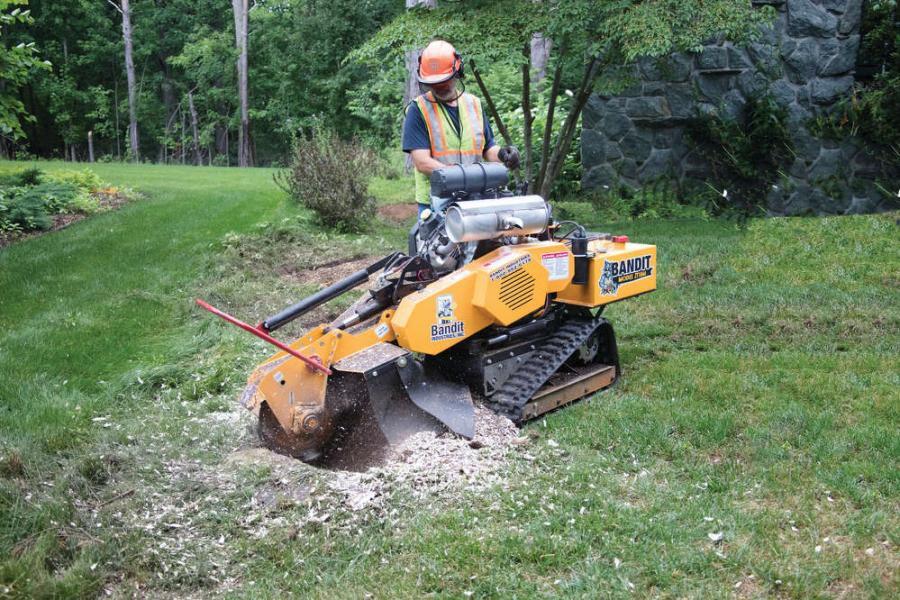 Stump grinders remove tree stumps by means of a rotating cutting disk. Stump grinders vary greatly in size, and can be as small as a lawn mower or as large as truck. Most accomplish their task by means of a high-speed disk with teeth that grinds the stump and roots into small chips.
Stump grinders remove tree stumps by means of a rotating cutting disk. Stump grinders vary greatly in size, and can be as small as a lawn mower or as large as truck. Most accomplish their task by means of a high-speed disk with teeth that grinds the stump and roots into small chips.
Typically, stump grinders consist of a cutter wheel with fixed carbide teeth. Cutter wheels are controlled by hydraulic cylinders that push the cutter head through the stump.
Some types of stump grinders can be attached to tractors or excavators. They can completely remove the roots of the trees in a few seconds, or alternatively, recover the central part of the roots.
Mulchers
 Mulchers for use in forestry and logging operations are a slightly different breed than those that typically serve home landscaping operations. Outfitted with either a fixed tooth rotor system or a swinging hammer, forestry mulcher size and power is tied to the horsepower capabilities of the tractor or vehicle to which it will be attached. Tree size mulching ability is generally larger in this type of mulcher, with the average circumference of trunk being roughly 40 centimeters or 16 inches in diameter.
Mulchers for use in forestry and logging operations are a slightly different breed than those that typically serve home landscaping operations. Outfitted with either a fixed tooth rotor system or a swinging hammer, forestry mulcher size and power is tied to the horsepower capabilities of the tractor or vehicle to which it will be attached. Tree size mulching ability is generally larger in this type of mulcher, with the average circumference of trunk being roughly 40 centimeters or 16 inches in diameter.
Yarders
A yarder uses a system of cables to pull or fly logs to a landing. Yarders consist of an engine, drums and spar, but have a variety of ranges and configurations, such as a swing yarder, so called because of its swing boom. Other yarders rely on a fixed boom.
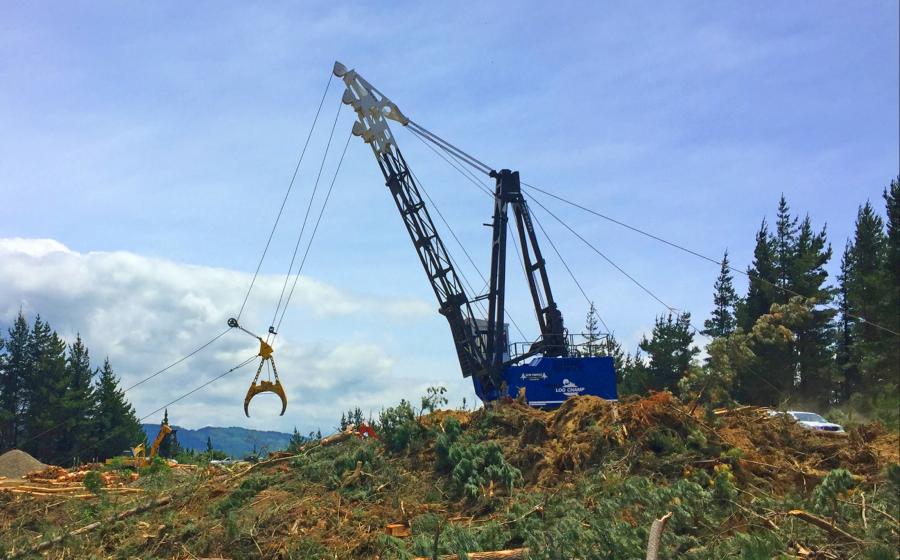
Swing booms can tackle a wider path and require fewer moves to transport a log or logs. It also offers more deflection for uphill yarding. However, fixed booms have higher towers, and can therefore work well in a deeper or varied landscape.
Carriers are the chassis section of yarder. A chassis supports the yarder and allows it to move. Chassis are either tracked or wheeled. There are also skid yarders, which have a flat bottom that allows it to slide among trees.
Yarders are either self-propelled or mobile, towed on a trailer moved by another vehicle, or carried, in the case of skid yarders.
The cables are mounted to towers. Towers can be small (up to 30 feet), medium (up to 60 feet), or large sized (up to 90 feet). Typically, they are made of wooden spars, steel (the most common material), or lattice, which are light but delicate. Towers are either single piece, folding, or telescoping, for easier transporting to and from job sites.
Cable yarders are employed when steep slopes or soil conditions reject ground based extraction methods.
Forwarders
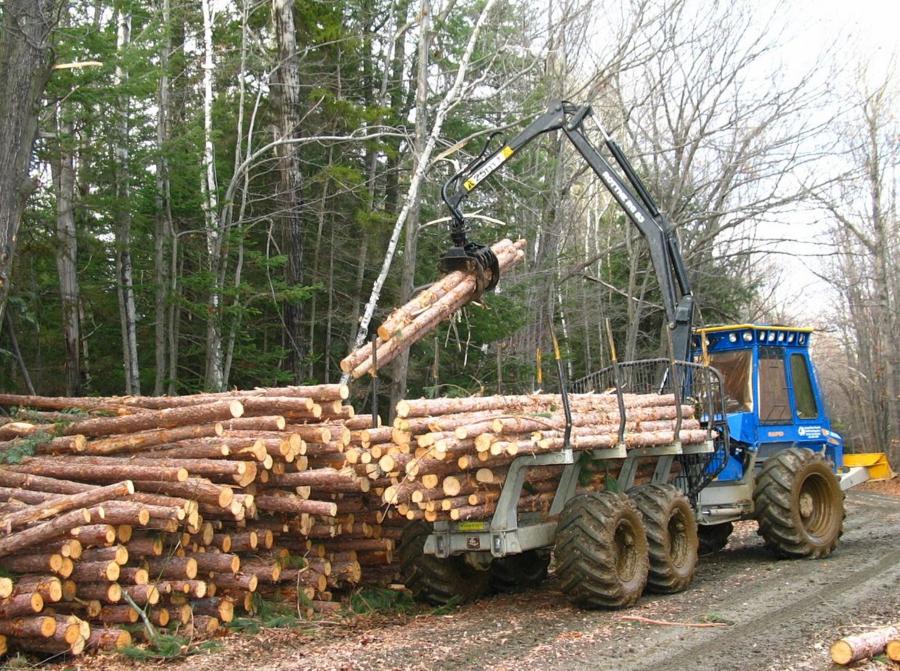 A forwarder moves large felled logs from the stump to a roadside landing. It differs from a skidder by lifting logs at least two feet above the ground, which reduces soil impact. Forwarders usually work with machines in logging operations that require cut-to-length results.
A forwarder moves large felled logs from the stump to a roadside landing. It differs from a skidder by lifting logs at least two feet above the ground, which reduces soil impact. Forwarders usually work with machines in logging operations that require cut-to-length results.
Categories of forwarders are based on their load carrying capabilities. The smallest may be towed by all-terrain vehicles. They can carry loads of between one and three tons. Agricultural forwarders may be towed by farm tractors, and can carry between 12 to 15 tons. Medium-sized forwarders used in clear-cutting carry between 12 and 16 tons. Additionally, there are lightweight forwarders made for commercial logging and thinning that can handle up to 8 tons.
Log Loaders
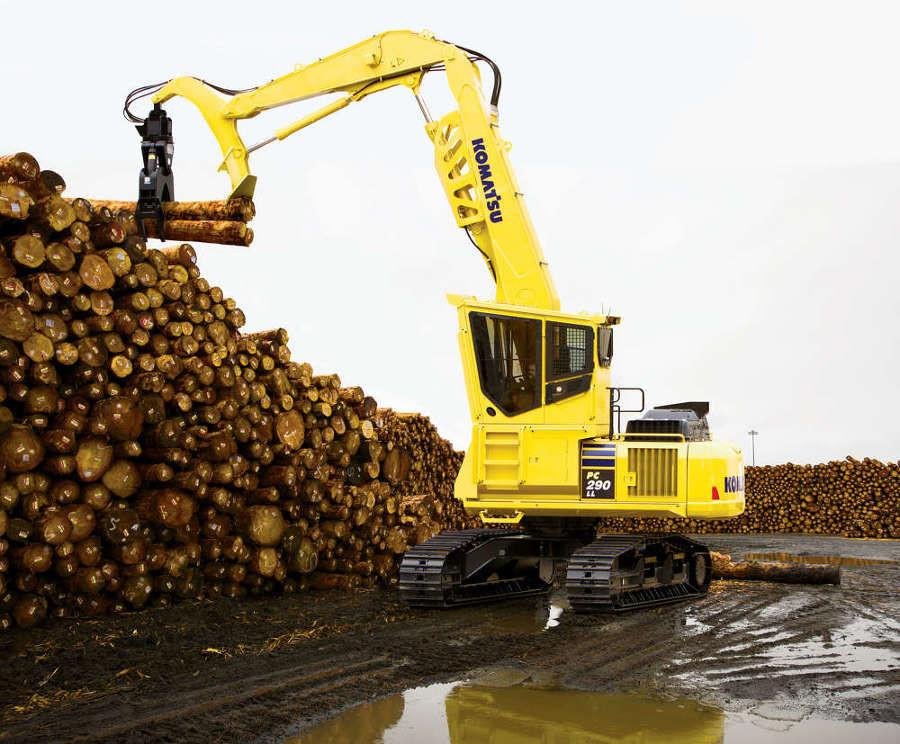 Log loaders sort and stack logs into piles. When the piles are of sufficient size, loaders move them onto transport trucks. There are three types of loaders: wheeled, capable of quick movement around the landing area; tracked, which are slower but more stable, and trailer mounted, which is the least expensive but must be pushed or pulled into place.
Log loaders sort and stack logs into piles. When the piles are of sufficient size, loaders move them onto transport trucks. There are three types of loaders: wheeled, capable of quick movement around the landing area; tracked, which are slower but more stable, and trailer mounted, which is the least expensive but must be pushed or pulled into place.
Loader machines are either knucklebooms or grapples. Knucklebooms have quick hydraulic systems for swing and boom purposes. Grapples may be either bunching, which allow for a bigger pickup base; pulpwood, which are designed for shorter lengths, and log grapples, which handle tree length sized logs. There are also butt-n-top grapples with heels on either side that allow for bunching of tree-length loads in increased load capacity-capable trucks. Finally, there are boom type loaders, which allow for greater control over log placement for both carrying and loading.
Knucklebooms are preferred when loading average sized trees. Shovel loaders are ideal in situations where piece sizes and volumes are too large for a knuckleboom loader.
Harvesters
 Harvesters are self-propelled cutting machines. They are able to both fell and process stems. Wheeled or tracked, they feature a cutting head that fells, delimbs, and bucks trees to specific lengths. Harvesters also have a front or rear cab for the operator, which is either fixed or rotating. Attached booms may be telescoping.
Harvesters are self-propelled cutting machines. They are able to both fell and process stems. Wheeled or tracked, they feature a cutting head that fells, delimbs, and bucks trees to specific lengths. Harvesters also have a front or rear cab for the operator, which is either fixed or rotating. Attached booms may be telescoping.
Tracked harvesters are ideal for tackling slopes. Wheeled harvesters have lower slope capabilities. Though they do well processing single stem trees such as conifers and aspen, they are not ideal for multi-limbed type trees.
Harvesters work well in conjunction with forwarders and self-loading trucks.
This story also appears on Forestry Equipment Guide.
Today's top stories








 A
A 













